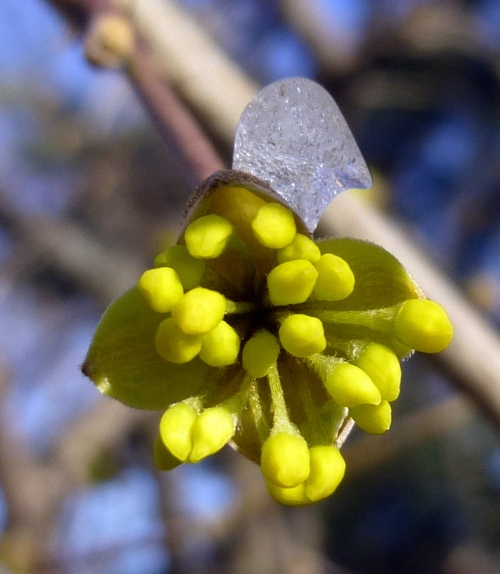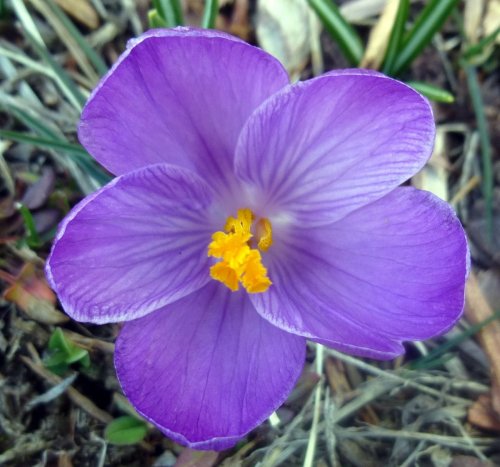More flowers are blooming daily now and it’s getting a little harder to keep up with them. Here are just a few that I’ve seen.

This striped sqill (Puschkinia scilloides, variety libanotica) was a big hit the last time I showed it here so I thought I’d give readers a little more information about where to find it. First, it is a spring flowering bulb that is planted in the fall, so it shouldn’t be ordered until mid to late summer. The only place I have been able to find it for sale is Brent and Becky’s Bulbs’ spring / fall catalog, which you can view online by clicking here. Our friends in the U.K. can order them through Kevock Gardens by clicking here. If you order these bulbs you should remember to specify the variety, which is Libanotica. I’m sorry to say that I wasn’t able to find a European supplier, but I’d bet that there is at least one out there.

Daffodils have just started blooming. These were the first ones I’ve seen.

This is the first magnolia blossom I’ve seen. It was very fragrant, with a scent that reminded me of cabbage roses or peonies. The temperature might drop as low as 25 degrees tonight-I hope the petals don’t get nipped by frost.

In the forest bloodroot (Sanguinaria canadensis) is all ready to bloom. This plant gets its common name from the way its root “bleeds” red sap when it is cut. Native Americans used the colored sap for decorating baskets, as war paint, and even as an insect repellant. Each plant has a single leaf and flower growing on separate stems.

False hellebore (Veratrum viride) has just come up over the last 3 or 4 days. Though it was used by Native Americans in various ways including medicinally, this plant is one of the most toxic n the New England forest. Unfortunately at this time of year it is also one of the most interesting, and big enough to make it hard to miss. Most people who eat it mistake it for ramps and eat the root, which is its most potent part.

I like the patterns made by the deep pleats in the leaves of false hellebore. Its small green flowers are interesting, but not very pretty. I went looking for them last year and never found them, so I’ll have to try again.

Yellow trout lily (Erythronium americanum ) isn’t blooming yet but I they are very close. Each pair of leaves sends up one stalk which bears a single yellow, nodding flower. This plant is also called dogtooth violet because of the underground bulbous root that looks like a tooth. The name trout lily comes from the way the mottled leaves resemble a trout’s body.

Spring beauties (Claytonia virginica) grow among the trout lilies. Each flower consists of 5 white, pink striped petals, 2 green sepals, 5 pink tipped stamens, and a single tripartite pistil, which means that it splits into 3 parts. Two days ago I didn’t see a single spring beauty blossom and now the woods are full of them.

It seems early for trilliums here but these plants were growing out of a crack in a boulder, so maybe the sun-warmed stone gave them an extra boost. These were very near a popular trail so I’m hoping nobody picks them before I get back to see the flowers.

These leaves might not look like much but they cause quite a stir each spring, even causing entire towns to close down to have festivals in this plant’s honor. These are ramps (Allium tricoccum,) also called ramson, wild leeks, wood leeks, wild garlic, and spring onions. Ramps are native and considered a vegetable. Note the difference between these plants and false hellebore, above. Ramps are said to have a strong, garlic like odor and a strong onion taste. I can only vouch for the odor-they do smell a bit like garlic, but more like onion to me. Native Americans called the plant chicagou and, since it grew there in abundance, the city of Chicago was named after it.

The white, swollen lower stem of ramps is what all the fuss is about. Ramps remind me of the fiddleheads from ferns that are available for just a short time in spring. Both plants are considered great delicacies and are served in upscale restaurants at astronomical prices. I haven’t seen any fiddleheads yet and was surprised at the size of these plants.

This dandelion (Taraxacum officinale) blossom is barely bigger than an acorn cap so it won’t win any prizes, but it’s the first one I’ve seen this spring. It seems like they are late this year.

We may have as many as nine different willow species here in New Hampshire and they all bloom at different times. This, one of the earliest, just started blooming. I believe the photo is of the male flower of Salix discolor, known as pussy or glaucous willow, but it could also be Goat Willow (Salix caprea.) Willows are one of my favorite spring flowers.

I hope you can stand another look at skunk cabbage (Symplocarpus foetidus.) I wanted to show people in places it doesn’t grow what the leaf looked like so they could see how much they really do resemble cabbage leaves at this stage. The leaves are the stinkiest part of the plant, so it’s doubtful that anyone could ever eat one by mistake. I had a woman stop while I was taking this picture and tell me that she was glad that these plants weren’t growing outside her bedroom window.
Blossom by blossom the spring begins~ Algernon Charles Swinburne
Thanks for stopping in.
Read Full Post »




































